Leo Minor is a small, faint constellation in the northern sky, with only one star brighter than fourth magnitude.
The constellation’s name means “the smaller lion” in Latin. Leo Minor was created by the Polish astronomer Johannes Hevelius in 1687. Hevelius created the constellation from 18 stars between the larger constellations Leo and Ursa Major.
Leo Minor is located between Ursa Major to the north, Cancer to the southwest, Lynx to the west, and Leo, which represents the larger lion, to the south. Notable deep sky objects in Leo Minor include Hanny’s Voorwerp, a quasar ionization echo, and the interacting galaxies Arp 107.
Facts, location and map
Leo Minor is the 64th constellation in size, occupying an area of 232 square degrees. It is located in the second quadrant of the northern hemisphere (NQ2) and can be seen at latitudes between +90° and -40°. The neighboring constellations are Cancer, Leo, Lynx and Ursa Major.
The constellation name Leo Minor is pronounced /ˈliːoʊ ˈmaɪnər/. In English, the constellation is known as the Lesser Lion. The genitive form of Leo Minor, used in star names, is Leonis Minoris (pronunciation: /liːˈoʊnɪs mɪˈnɒrɪs/). The three-letter abbreviation, adopted by the International Astronomical Union (IAU) in 1922, is LMi.
Leo Minor does not have any stars brighter than magnitude 3.00 or located within 10 parsecs (32.6 light years) of Earth. The brightest star in the constellation is Praecipua (46 Leonis Minoris), with an apparent magnitude of 3.83. The nearest star is the binary system 11 Leonis Minoris (spectral class G8V/M5V), located at a distance of 36.46 light years from Earth.
The constellation contains two formally named stars. The star names approved by the International Astronomical Union (IAU) are Illyrian and Praecipua.
Leo Minor has three stars with known exoplanets, HD 87883 (spectral class K0V), HD 82886 (G0D), and Kelt-3 (F2D).
Leo Minor belongs to the Ursa Major family of constellations, along with Boötes, Camelopardalis, Canes Venatici, Coma Berenices, Corona Borealis, Draco, Lynx, Ursa Major and Ursa Minor.
Leo Minor does not contain any Messier objects. The Leo Minorids are the only meteor shower associated with the constellation. It takes place from October 19 to 27 every year and is linked to the comet C/1739 K1.
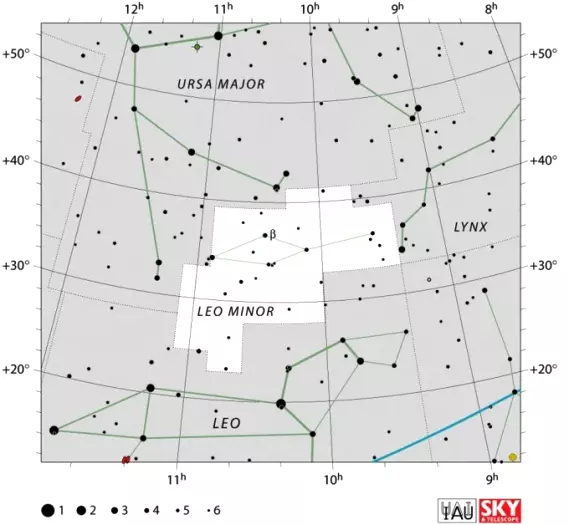
Leo Minor constellation map by IAU and Sky&Telescope magazine
Story
Leo Minor is a relatively new constellation, and has no myths associated with it. It was first depicted in 1687 in Johannes Hevelius’ Catalogus Stellarum Fixarum. In 1845, the catalogue was revised by Francis Baily, who assigned Greek letters to stars that were brighter than magnitude 4.5, but he did not give the constellation’s brightest star the designation Alpha in his British Association Catalogue.
In 1870, the English astronomer Richard A. Proctor renamed the constellation to Leaena, or the Lioness, in an attempt to shorten constellation names in order to make them easier to manage on star charts, but the name was not widely adopted.
Leo Minor stars
Praecipua (46 Leonis Minoris)
Praecipua is the brightest star in Leo Minor. It has an apparent magnitude of 3.83 and is 94.9 light years distant from the Sun. It has the stellar classification of K0+III-IV, which means that it is an orange star halfway between the subgiant and giant stage of evolution. The star has 1.5 solar masses, is 32 times more luminous than the Sun, and has a diameter 8.5 times solar.
46 Leonis Minoris was presumably intended to get the Alpha designation, but the English astronomer Francis Baily, who had decided to letter all the stars brighter than magnitude 4.5, omitted the designation from his catalogue.
The star’s Latin name, Praecipua, means “the chief (star of Leo Minor).”
β Leonis Minoris (Beta Leonis Minoris)
Beta Leonis Minoris is the only star in Leo Minor that has a Greek letter name. It is the second brightest star in the constellation.
Beta Leonis Minoris is a binary star. The components have stellar designations G8III-IV and F8IV, which means that they are a yellow giant-subgiant and a yellow-white subgiant. The brighter star is 36 times more luminous than the Sun and has about twice the mass. It has 7.8 times the Sun’s radius. The companion is 5.8 times more luminous and has 1.35 solar masses. It has twice the solar radius.
The stars have apparent magnitudes of 4.40 and 6.12 and are approximately 146 light years distant from the Sun
21 Leonis Minoris
21 Leonis Minoris is the third brightest star in the constellation. It has an apparent magnitude of 4.49 and is 92.1 light years distant from the solar system. It has the stellar classification os A7V, which means that it is a white dwarf.
10 Leonis Minoris
10 Leonis Minoris is a yellow giant with the stellar classification of G8III. It has an apparent magnitude of 4.60.
37 Leonis Minoris
37 Leonis Minoris is a yellow supergiant belonging to the stellar class G2.5IIa. It has an apparent magnitude of 4.69 and an absolute magnitude of -1.84. The star is approximately 580 light years distant from the solar system.
20 Leonis Minoris
20 Leonis Minoris is another binary star in Leo Minor. It has an apparent magnitude of 5.40 and is 49.1 light years distant from Earth.
The system consists of a yellow dwarf belonging to the spectral class G3 Va and an old red dwarf of the spectral type M6.5. The two stars are separated by 14.5 seconds of arc.
11 Leonis Minoris
11 Leonis Minoris is another star system in Leo Minor. The primary star is a yellow dwarf belonging to the spectral class G8V. The star is a bit more massive than the Sun, and slightly dimmer. It has an apparent magnitude of 5.41. The primary component is classified as an RS Canum Venaticorum type variable, which means that it is a close binary star with an active chromosphere which can cause large stellar spots, which in turn cause variations in brightness. The star’s luminosity varies by 0.04 magnitudes.
The companion is a red dwarf of the spectral type M5V. It has an apparent magnitude of 13.0.
11 Leonis Minoris is 36.5 light years distant from the solar system.
HD 87883
HD 87883 is an orange dwarf star belonging to the spectral class K0V. It has an apparent magnitude of 7.56 and is approximately 59 light years distant from the solar system. It is believed to be about 9.8 billion years old.
A planet was discovered orbiting the star on August 13, 2009. HD 87883 b, the exoplanet, is a long-period planet; it takes seven and a half years to complete an orbit around the star.
Deep sky objects in Leo Minor
Hanny’s Voorwerp and IC 2497
Hanny’s Voorwerp is a quasar ionization echo, a rare type of astronomical object that was considered an unidentified astronomical object at the time of discovery. It was first spotted by Hanny van Arkel, a Dutch school teacher, in 2007. She discovered the object while taking part in the Galaxy Zoo project as an amateur volunteer. The object’s name, Hanny’s Voorwerp, means Hanny’s object in Dutch.
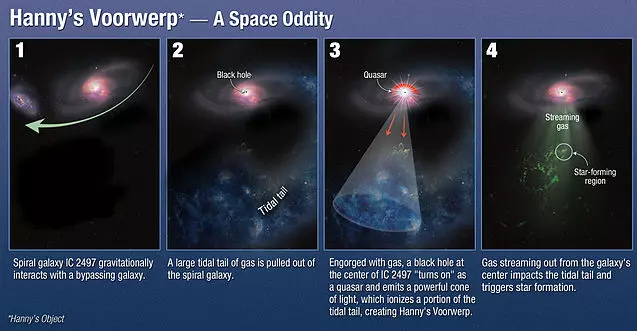
Astronomers found that Hanny’s Voorwerp is the only visible part of a 300,000-light-year-long gaseous tail stretching around the galaxy. The greenish Voorwerp is visible because a searchlight beam of light from the galaxy’s core illuminated it. This beam came from a quasar, a bright, energetic object that is powered by a black hole. An encounter with another galaxy may have fed the black hole and pulled the gaseous tail from IC 2497. Image: NASA, ESA, and A. Feild (STScI)
Hanny’s Voorwerp is located near the spiral galaxy IC 2497 and appears as a bright blob. The object is believed to be the size of the Milky Way galaxy. It has a large central hole, approximately 16,000 light years across. Both the object and the galaxy are about 650 million light years distant from Earth.
Star formation is occurring in the region of Hanny’s Voorwerp which is facing the galaxy. It is thought to be the result of the outflow of gas from the galaxy’s core and the gas interacting with a region of the object. The youngest stars in the region are several million years old.
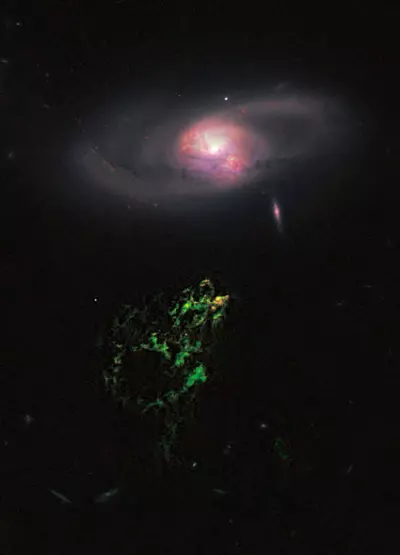
This Hubble view uncovers a pocket of star clusters, the yellowish-orange area at the tip of Hanny’s Voorwerp. The star clusters are confined to an area that is a few thousand light-years wide. The youngest stars are a couple of million years old. The Voorwerp is the size of the Milky Way, and its bright green colour is from glowing oxygen. The image was made by combining data from the Advanced Camera for Surveys (ACS) and the Wide Field Camera 3 (WFC3) onboard Hubble, with data from the WIYN telescope at Kitt Peak, Arizona, USA. The ACS exposures were taken 12 April 2010; the WFC3 data, 4 April 2010. Image: NASA, ESA, William Keel (University of Alabama, Tuscaloosa), and the Galaxy Zoo team
A theory suggests that Hanny’s Voorwerp is composed of remnants of a small galaxy revealing the impact of radiation from a quasar event that took place in the central region of IC 2497 some 100,000 years ago. The quasar event is believed to have stimulated the bright emission. A theory explaining the absence of a light source is that, because the object and the galaxy are between 45,000 and 70,000 light years apart, the voorwerp is showing a ghost image of the illumination of the quasar, or a light echo of events that occurred before those currently seen in IC 2497.
A more recent theory suggests that the illumination comes from a supermassive black hole at the centre of the galaxy, and from the light produced by the interaction of the gas surrounding the galaxy and an energetic jet from the black hole.
Arp 107
Arp 107 is a pair of interacting galaxies approximately 450 light years distant from Earth. The galaxies are in the process of merging. They have an apparent magnitude of 14.6.
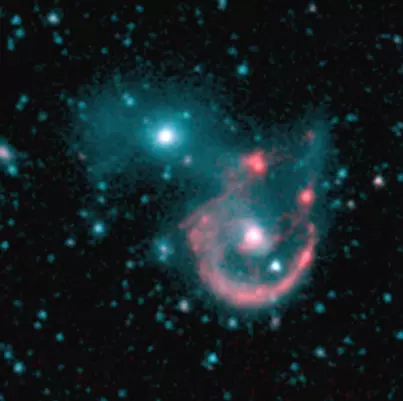
Interacting galaxy pair Arp 107. Image: Bild tagen av:B. J. Smith (East Tennessee State University)
NGC 3432
NGC 3432, sometimes known as the Knitting Needle Galaxy, lies 3 degrees southeast of the star 38 Leonis Minoris. It appears almost edge-on and can be observed in amateur telescopes. The galaxy has an apparent magnitude of 11.67 and is about 42 million light years distant from the solar system.
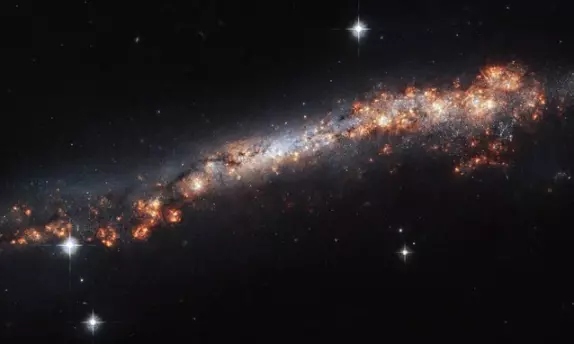
ESA/Hubble & NASA, A. Filippenko, R. Jansen
NGC 3003
NGC 3003 is a barred spiral galaxy in Leo Minor. It is 5.8 arc minutes in size and has an apparent magnitude of 12.3. It appears almost edge-on.
NGC 3344
NGC 3344 is a spiral galaxy seen face-on. It is approximately 25 million light years distant and 7.1×6.5 arc minutes in size. It has an apparent magnitude of 10.5.
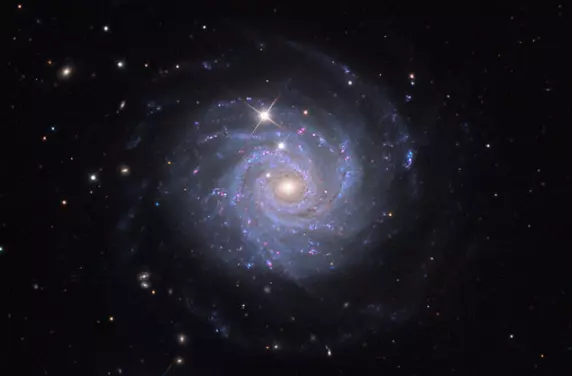
NGC 3344, image: Adam Block/Mount Lemmon SkyCenter/University of Arizona (CC BY-SA 4.0)
NGC 3504
NGC 3504 is a barred spiral galaxy with an apparent magnitude of 11.67. It is a starburst galaxy, a region of massive star formation. Two supernovae were observed in the galaxy in recent years, one in 1998 and another in 2001.
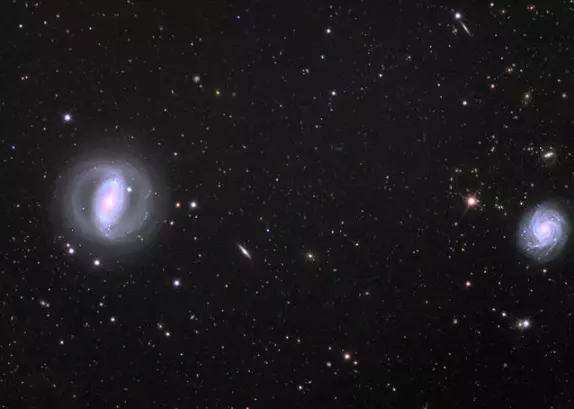
Barred spiral galaxy NGC 3504 and spiral galaxy NGC 3512, image: Wikimedia Commons/Jschulman555 (CC BY-SA 4.0)
NGC 3486
NGC 3486 is a type Sb spiral galaxy, also appearing almost face-on. It has an apparent magnitude of 11.0.
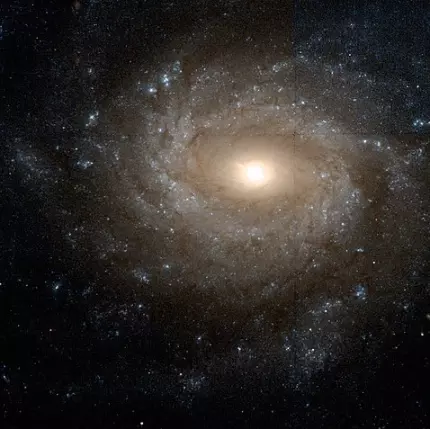
NGC 3486, image based on observations made with the NASA/ESA Hubble Space Telescope, and obtained from the Hubble Legacy Archive, which is a collaboration between the Space Telescope Science Institute (STScI/NASA), the Space Telescope European Coordinating Facility (ST-ECF/ESA) and the Canadian Astronomy Data Centre (CADC/NRC/CSA).
NGC 3021
NGC 3021 is a spiral galaxy with a visual magnitude of 10.88, located at an approximate distance of 100 million light years away. The galaxy occupies an area 1.6’ by 0.9’ in size. A supernova, SN 1995al, was discovered in the galaxy in 1995.
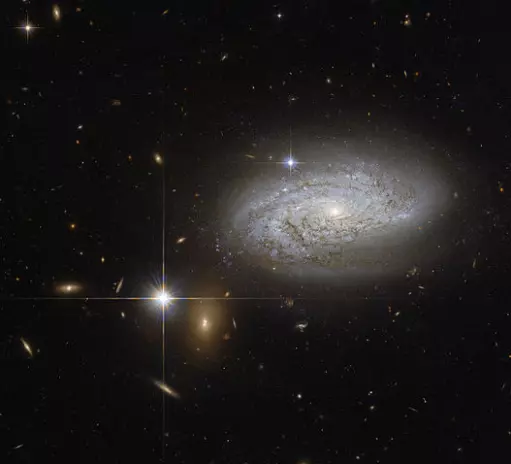
This NASA/ESA Hubble Space Telescope image shows the spiral galaxy NGC 3021 which lies about 100 million light-years away in the constellation of Leo Minor (The Little Lion). Among many other types of stars, this galaxy contains Cepheid variable stars, which can be used work out the distance to the galaxy. These stars pulsate at a rate that is closely related to their intrinsic brightness, so measurements of their rate of pulsation and their observed brightness give astronomers enough information to calculate the distance to the galaxy itself. Cepheids are also used to calibrate an even brighter distance marker, which can be used over greater distances: Type Ia supernovae. One of these bright stars was observed in NGC 3021, back in 1995. In addition, the supernova in NGC 3021 was also used to refine the measurement of what is known as the Hubble constant. The value of this constant defines how fast the Universe is expanding and the more accurately we know it the more we can understand about the evolution of the Universe in the past as well as in the future. So, there is much more to this galaxy than just a pretty spiral. Image: NASA & ESA / Acknowledgement: A. Riess (STScI)
NGC 2859
NGC 2859 is a barred lenticular galaxy about 82.2 million light years away. The galaxy has an apparent magnitude of 11.8 and an apparent size of 4.3’ by 3.8’. The galaxy’s central supermassive black hole has an estimated mass 105 million times that of the Sun.
NGC 2859 has a strong bar and a secondary bar positioned at nearly a right angle, but is lacking in visible spiral arms. The galaxy’s outer region has a conspicuous, detached ring.
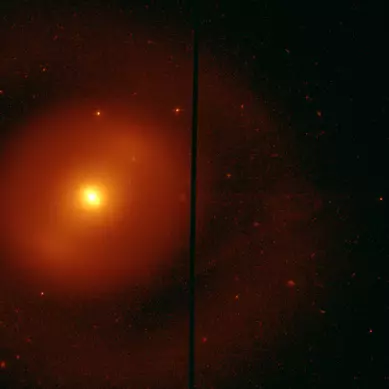
NGC 2859, image based on observations made with the NASA/ESA Hubble Space Telescope, and obtained from the Hubble Legacy Archive, which is a collaboration between the Space Telescope Science Institute (STScI/NASA), the Space Telescope European Coordinating Facility (ST-ECF/ESA) and the Canadian Astronomy Data Centre (CADC/NRC/CSA).
Leo Minor is also home to the Seyfert galaxies 3C 234 and 3C 223 with a quasar-like appearance, and AGC 198691, a small galaxy nicknamed Leoncino. Leoncino has the smallest known metallicity, which indicates the kind of galaxies that were first formed in the Universe.